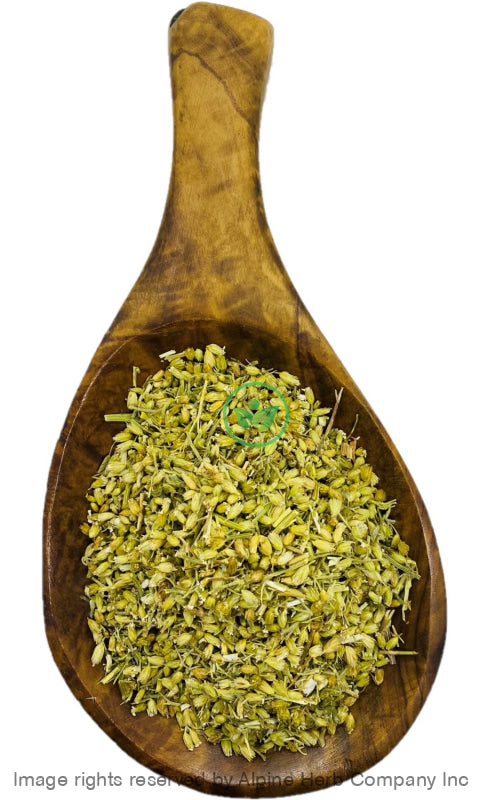Yarrow Flower Cut Alpine Herb Company Inc.
$ 8,49 $ 5,09
Botanical Name: Achillea millefolium
Common Name:
- English: Common Yarrow
- Herbe De Millefeuille, Hezarbarg, Jungfraukraut, Katzenkraut, Knight’s Milfoil, Mil De Tama, Mil En Rama, Mil Fl Ores, Mil Hojas, Milefolio, Milfoil, Millefolium, Milenrama, Nosebleed, Old Man’s Pepper, Oum Alf Ouraka, Pharange, Saigum, Sanguinary, Sataraatyoutas, Schafgarbe, Schafgarbenkraut, Seiyonokogiriso, Seiyounokogirisou, Sneezeweed, Soldier’s Milfoil, Stratictes, Tansy, Thou Alf Ouraka, Thousand Leaf, Thousand Leaf Grass, Thousand Seal, Thousand Weed, Trava Tysyachelistnik, Troneto, Umm Alf Waraqah, Western Yarrow, Wound Wort, Yarrow, Yerba De Carpintero, Yerba De La Muela, Gandana, and Rojmari.
Habitat: Native to Asia, Europe, and North America
Origin: Ukraine
Harvested: Wild or cultivated
Parts Used: Flower
General Information:
Achillea millefolium, is a perennial herb that belongs to the Asteraceae family, 30-90 cm in height, with an aromatic odor, greyish green color from the numerous small hairs; stem angular and has no branches except near the top. It was known for 2000 years ago and was recorded firstly into the medical textbook of Dioscorides. Achillea millefolium was named after Achilles, the Greek mythical figure who used it to stop the bleeding wounds of his soldiers.
The leaves are alternate, 3-5 inches long, with many leaflets on each side of the midrib and these are further divided into smaller leaflets, giving them a delicate, fernlike, lacy appearance. They are green or greyish-green, faintly pubescent on the upper surface and more pubescent on the lower surface, 1-3 pinnately divided with linear lobes and a finely pointed whitish tip, alternate, clustered at the base of the stem. Flower heads are arranged in large, compact clusters at the top of the stem, each cluster consisting of one or more flower heads. The flower head has 20-25 yellowish-white ray flowers and similarly colored disk flowers. The flowers are typically white, but either pink or pale purple flowers are common in mountain areas. The petals are densely arranged in flattened clusters, and the leaves look like feathers.
The plant spreads rapidly. Yarrows can be planted to combat soil erosion due to the plant’s resistance to drought. The flowers, leaves, and stems of the Yarrow (Achillea millefolium) plant are used for medicinal purposes. It is collected while in bloom.
How to use:
Hot Infusion:
The basic method for dried herbs and flower is, take 2-3 tablespoons of dried herb in a cup or teapot. Pour hot water over it and cover it with lid for 10-30 minutes. Hot water is needed to draw out the antioxidants, enzymes, vitamins, flavonoids, and volatile oils from the botanicals. Strain and squeeze out as much as liquid as possible and enjoy!
Tips:
- You can sweeten your herbal tea with a bit of honey, natural fruit juice, stevia leaves powder and or licorice root powder.
- You can make ice cubes or pops by freezing tea in ice trays or pop molds.
Precautions:
You should consult with a qualified healthcare practitioner before using any herbal products, particularly if you are pregnant, nursing, or on any medications.
All information on this website is for educational purposes ONLY.
This information has not been evaluated by Health Canada.
This information is not intended to diagnose, treat, cure, or prevent any disease.
| Unit Size | 100g, 200g, 400g, 1kg |
|---|
Prompt shipping and expert packing
Thanks to our longstanding association with UPS FedEx DHL as well as other leading global carriers, we can offer a variety shipping options. Our warehouse staff is highly trained and will be able to pack your goods in accordance with our precise and exact specifications. Your items will go through an exhaustive examination before they will be securely packaged before being delivered. We ship to hundreds of thousands of customers daily in different countries. This is a sign of our determination to become the largest online retailer worldwide. Warehouses and distribution centers are located throughout Europe as well as in the USA.
Note that orders containing multiple items are processed according to the particular item.
We will thoroughly inspect all items ordered before shipping. Most orders are shipped within 48 hours. The delivery time will be between 3 and 7 working days.
Returns
The stock market is always changing. It's not entirely managed by us since we're involved with several entities, including the factory and the storage. Therefore, the actual inventory could fluctuate at any moment. Please be aware that it is possible that your order could be out of stock after you've placed your order.
Our policy lasts for 30 days. If it's been more than 30 days since the date you purchased your item We're sorry to say that we can't offer you a full exchange or refund.
You can only return a product if it is unused and still in the same state as when you received it. The item should be in the original packaging.


































